
Pavel Tsatsouline: Return Of The Kettlebell Master
The kettlebell isn't just for fat-burning. It's a strength-builder that some of the world's mightiest lifters swear by. Hear the case for it from the man who brought it over from Russia! Pavel Tsatsouline doesn't care about your age, weight, or background. He wants you to pick up that kettlebell!
Pavel Tsatsouline swung into prominence on the rounded handle of the kettlebell back in 2001, with the release of his training manual "The Russian Kettlebell Challenge." But today, this now-common iron ball only forms part of his prolific body of work.
Over the last 15 years, the former Russian special ops trainer has published books about mobility and stretching, abdominal work, bodybuilding, and plenty about barbells—including a recent paean to the deadlift co-authored with English powerlifter Andy Bolton.
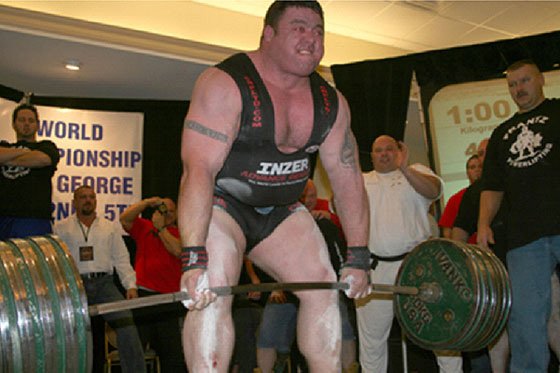
Modern strength coaches point to his popularization of various high-tension techniques, programs using ascending rep ladders, movements like the RKC plank, and "greasing the groove" by practicing difficult movements throughout the day. Powerlifters can thank (or curse) him for the Smolov squat cycle and other Iron Curtain training relics he helped bring to light.
Collectively, these ideas constitute "hard-style" training, a remarkably cohesive and adaptable approach that "reverse engineers what strong people do naturally," as powerlifter and strength coach Louie Simmons has said of Tsatsouline. All of his work emphasizes simple programming, maximal tension, and "practicing" difficult movements rather than "working out."
Along the way, Tsatsouline also started the Russian Kettlebell Challenge (RKC), a teaching certification renowned for its meticulous technique and grueling physical examinations. But in 2012, he and a number of RKC insiders split away to form StrongFirst, a "school of strength" that offers barbell and bodyweight courses and certifications in addition to kettlebells. But lest anyone think that he has "taken a hard right toward 1RM strength," as he wrote in a blog post, Tsatsouline has returned to the kettlebell workout in his new book "Kettlebell: Simple and Sinister."
"Kettlebell: Simple & Sinister" is perhaps Tsatsouline's most bare-bones program yet, but also his meanest. It comprises only two movements (plus a brief warm-up routine) to be repeated daily, with rest days only as necessary, until several universal strength benchmarks are met. It doesn't offer any breaks or customizations for bodyweight or age, but rather simply declares, in the book's final words: "Repeat until strong."
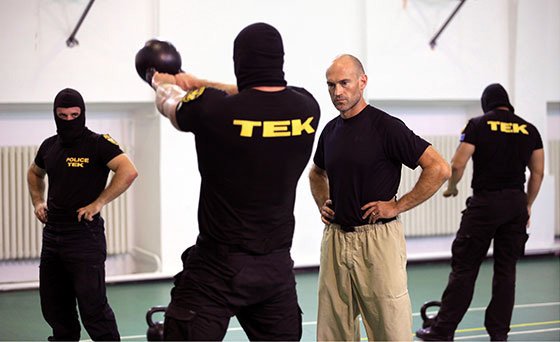
Simplicity is nothing new to followers of Tsatsouline's work. He's written three other books based on programs with only two movements: "Power to the People," "The Naked Warrior," and "Enter the Kettlebell." But in these, he still allowed for the slightest bit of customization: a biceps curl here, some low-rep ab training there, a bit of modular program-weaving when it didn't seem to hurt anything. No more.
"Simple & Sinister" has no mention of his previous programs, no discussion of what comes next. He has pared it down from "If you simply must do this…" to "You simply must do this."
Prior to the book's release, Tsatsouline talked with us about the next advance of the Russian kettlebell invasion.
How have your hopes or expectations for the kettlebell changed over the dozen years since "The Russian Kettlebell Challenge" came out?
In Russia, the kettlebell traditionally has been a training tool for tough people. When I started teaching kettlebells to Americans, I saw the same pattern; my early students were military operators, fighters, and other hard men.
What pleased and surprised me over the years is how this hardcore tool went on to appeal to people from all walks of life. My teaching goals used to be narrow: Make the tough even tougher. Today they are broader: Enable regular folks to join the tough. Finally become the man or woman you used to want to be.
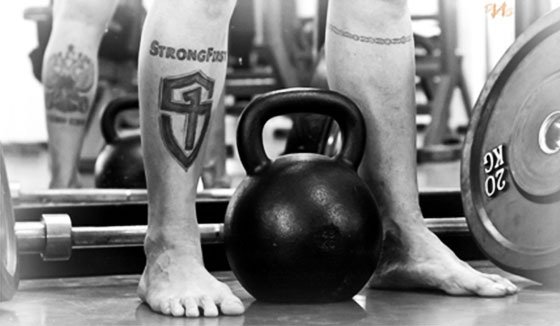
The Russian kettlebell has a lot to offer to a bodybuilder. In my book "Return of the Kettlebell," I explained the science behind using repetition kettlebell quick lifts for hypertrophy. In a nutshell, fast eccentrics physically "tear" up the muscles; a metabolic upheaval from extremely demanding full-body quick lifts "tears" them up chemically with free radicals.
The results are extraordinary, even at the elite level. Powerlifting world champion Brad Gillingham quickly added meat to his back, hams, and glutes just from a few sets of hard style swings with an 88-pound kettlebell. Amuse yourself: This is exactly 10 percent of his 881-pound deadlift.
I taught powerlifter Donnie Thompson how to train with kettlebells for power. In just three months Donnie packed 26 pounds of muscle on his already overwhelmingly muscular frame. In nine months kettlebells added 65 pounds to his deadlift and 100 pounds to his bench press. Today Thompson owns the highest powerlifting total in history: 3,000 pounds.
My "Deadlift Dynamite" co-author Andy Bolton, the man who cracked the historic 1,000-pound deadlift barrier, swears by kettlebells. But note that stimulating hypertrophy with kettlebells demands a very particular "hard-style" technique and specific programming. Refer to "Return of the Kettlebell" (once you have dialed in kettlebell fundamentals).
The kettlebell, by all appearances, is here to stay. But along with that comes an explosion of cheap 3-pound pink kettlebells and similar iterations. What, if anything, gets lost in the process of popularization?
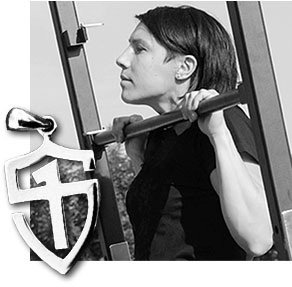
Nothing gets lost on the professional and serious amateur level. Everything gets lost in the mass market. It does not bother me. People who buy pink kettlebells and similar nonsense live in a parallel universe I have no interest in. They are flakes drifting from one "build muscle fast" and "lose fat tomorrow" scheme to the next. They will never achieve their goals, and I have no intention of wasting my time motivating them. I preach to the choir.
I am not saying that serious kettlebell training is elitist. Not at all. The price of admission is a strong spirit and attention to detail. At a recent StrongFirst kettlebell cert, one of the students was an extremely motivated young man with cerebral palsy.
You're no longer involved with the RKC, but you now have a new organization that also offers certifications, StrongFirst. What are your hopes for this organization, and how has the response been thus far?
Right after StrongFirst was founded one of our instructors apologized for a slip of the tongue—saying "RKC" instead of "SFG". Our CEO Mark Toomey responded: "There is nothing to apologize for. We are RKC. The Chief, the people, the system, the traditions—they are all here."
StrongFirst is a school of strength. We teach men and women how to quickly and safely reach high levels of strength without interfering with their duty, job, or sport. Our instructor team includes national champions, national team coaches, former special operators, elite martial artists, national team doctors, performing strongmen, and other high-end strength professionals.
The response has been exceptional. StrongFirst instructor certs—kettlebell, bodyweight, and barbell—have been extremely popular around the world and we are opening more and more user courses.
What sort of people do you want to be StrongFirst instructors?
The kind of person I would feel comfortable to entrust my wife or my mother to—be it in the gym or walking home through a dark alley.
StrongFirst instructor trainees come from all walks of life: champion athletes, special operators, elite coaches, medical professionals, and strong-minded regular folk. Almost half are ladies.
The written test is the easiest part of the cert. StrongFirst subjects its instructor candidates to a "martial arts belt test." The student has to demonstrate perfect exercise technique, have his or her spirit tested in grueling workouts, pass strength tests, and demonstrate teaching skills. Walking the walk is the only way to earn the StrongFirst instructor designation.
Not surprisingly, our kettlebell cert is extremely demanding mentally and physically and requires extensive preparation. In spite of the high caliber of the individual it attracts, typically 30 percent of the students fail.
Our barbell and bodyweight certifications are not smokers, but they demand strength and attention to detail. Consider that in order to graduate from our bodyweight training instructor course, a student must be able to do a strict one-arm pushup—and that is the ladies' standard.
StrongFirst has a more explicitly tactical appearance than your former work. How central is training soldiers and law enforcement to this phase of your career?
Always front and center. I come from a country where, eerily, World War II never ended. Russians never forgot the sacrifices of their soldiers. Americans ought not to as well.
I am proud to be a subject matter expert to elite U.S. military and law enforcement special operations units. Here is an example of what operators say about StrongFirst methods: "And suddenly the Hindu Kush was easy."
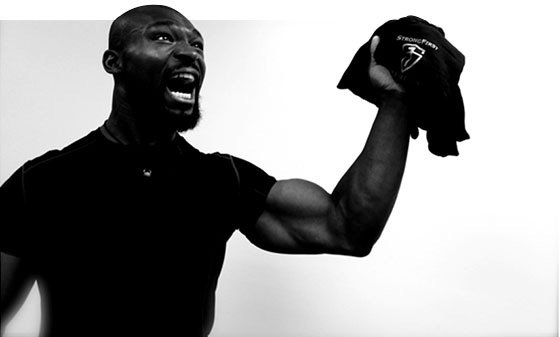
StrongFirst's motto is "Strength has a greater purpose." Two images come to mind. One is of U.S. Marines fighting for their god and country. The other is a scene from the movie "Trains, Planes, and Automobiles." Steve Martin's character Neal is a successful executive. He meets John Candy's character Del—a traveling salesman who lost his wife and his home—and invites him to join him and his family for a Thanksgiving dinner. Neal helps Dell to carry his monstrous trunk, which contains all of the latter's worldly possessions. "Strength has a greater purpose."
Tell us about your new book, "Kettlebell: Simple & Sinister."
I owe the title to a U.S. counterterrorist operator who used it to describe my system. The book outlines a foolproof foundational program for any driven person—from de-conditioned to champion. Because, as Russian scientists established beyond the shadow of a doubt decades ago, any "sport-specific" or goal-specific training must be done on a foundation of general physical preparation (GPP).
The Russian concept of GPP got misinterpreted in the West as metabolic "smokers." Nothing could be further from the truth. GPP embraces all attributes: strength, flexibility, endurance, etc. And when Russians talk about "general" development, they imply a wide carryover to a great many applications: "… the ability … to perform any physical work more or less successfully." (Ozolin, 2005)
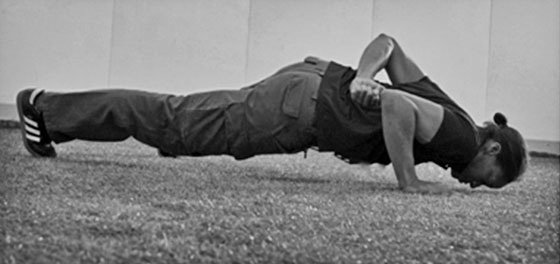
Thus GPP is about developing all fitness components with means carefully selected to have the widest possible carryover. Consider two familiar exercises: the leg extension and the barbell squat. The former makes you better at one thing only: the leg extension. This makes it a poor choice for GPP. The barbell back squat, on the other hand, makes you jump higher, run faster, hit harder, etc.
Thus the squat is a good GPP exercise and the leg extension is not. GPP is what "functional training" was supposed to be but failed, confused and distracted by what Mark Reifkind, Master SFG, calls "random acts of variety."
"Kettlebell: Simple & Sinister" will teach you how to build a rock-solid general base for your specialized training in bodybuilding, powerlifting, etc. Nothing does it better than the kettlebell. Consider the hard-style kettlebell swing. Which other exercise can increase both a professional powerlifter's strength and an elite marathoner's endurance?
Note that there is a world of difference between swinging a kettlebell and performing a proper hard-style swing. The devil is in the details. And this is where "Kettlebell: Simple & Sinister" comes in. I have written it in the tradition of "The Naked Warrior," with a laser focus and obsessive attention to detail.
Kettlebell: Simple & Sinister is your education in moving strong.
Several of your best-known programs only contain two or three movements. What benefit would the modern bodybuilder or CrossFit WOD-survivor get out of spending a few weeks in a program like that?
It is all about focus. Your body's adaptation reserves are limited, and so is your training time. A comparison to a family budget invites itself. You could go on a memorable vacation, buy a couch, or waste your dollars on gadgets, apps, and cappuccinos.
If you chose "A" or "B," you will have great memories or a durable piece of furniture. Choose "C" and tomorrow you feel like you have nothing to show for your money, because you do not.
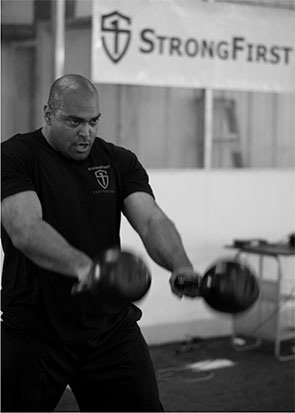
Minimalist programs like "Power to the People!" or "Kettlebell: Simple & Sinister" enable lifters to achieve real and measurable progress. Do not confuse "minimalistic" with "beginner." A great many elite power athletes strength train with a limited number of exercises. Coach Barry Ross put 17-year-old Allyson Felix on the "Power to the People!" regimen of deadlifts and bench presses, and she ran a world-record 200-meter sprint.
StrongFirst Master Instructor Doug Nepodal has been strength coaching Brazilian jiu-jitsu three-time world champion Fabio Leopoldo for five years. The bulk of the training is two exercises: the kettlebell swing and the kettlebell get-up—the "Kettlebell: Simple & Sinister" regimen.
Remember: most exercises do not matter.
Regardless—or perhaps because—of the seeming simplicity of your programs, you must have seen countless bizarre interpretations of them. What is the importance of "the program as written" in an age of unlimited fitness information?
Most of it is not information but noise. And even quality materials often do disservice to the reader who does not have the persistence to stick to one training system.
Ronen Katz, a StrongFirst instructor and 6th Dan in Kyokushin karate, told me a parable. A villager asked a wise man how to find water. "Dig down 10 meters," was the answer. A few days later the villager returned complaining that he had done as told and found no water. The wise man came over to take a look: the villager had dug 10 holes, each 1 meter deep.
Pick one system and dig deep in one place. It is the only path to the "water" of your goals.
Many writers on our site and others advocate going to failure for every movement, or perhaps even every set. It seems more common than ever, but you've often spoken out against failure. Explain.
StrongFirst Master instructor David Whitley stressed: "Do not look for differences in training of strong people; look for commonalities."
Andy Bolton does not train to failure. Brad Gillingham does not train to failure. Konstantin Konstantinov does not train to failure. Case closed.
